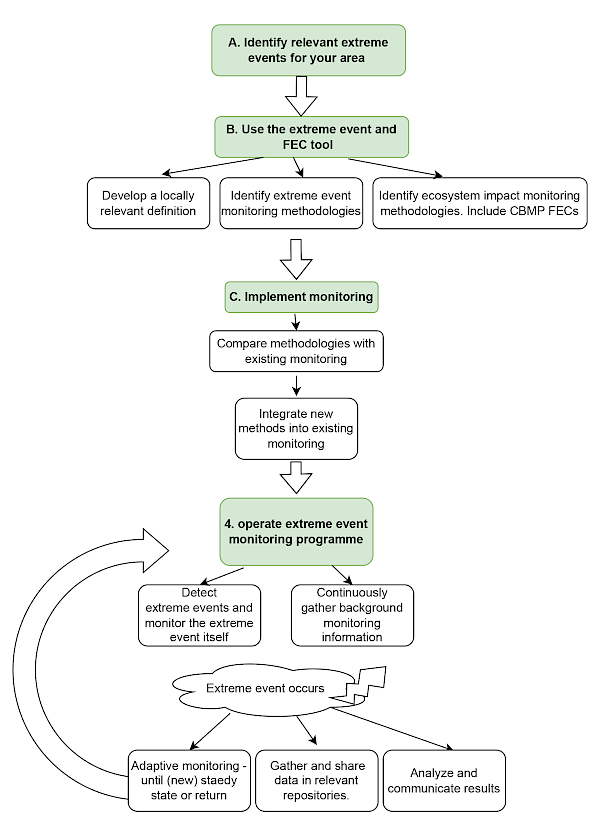Extreame events - Guidelines

Guidelines for integrating extreme event monitoring into existing long-term climate and ecosystem monitoring efforts (e.g. research stations, long-term ecosystem research and monitoring programmes).
Process to integrate extreme events into existing monitoring efforts
A. Identify relevant extreme events.
- Determine which extreme events are pertinent to your area.
B. Use the extreme event and FEC tool to:
- Develop a locally relevant definition of the extreme event
- Identify extreme event monitoring methodologies to:
- Detect the extreme event (consider setting up an ‘alarm system’ to notify staff if an extreme event occurs).
- Quantify the extreme event (e.g., measure the size of affected areas, increase monitoring frequency).
- Identify ecosystem impact monitoring methodologies to:
- Include CBMP FECs in a continuous background monitoring programme to assess impacts of specific extreme events.
- Implement additional methods to assess ecosystem impacts, if necessary (e.g. establish new monitoring to assess ecosystem impact in affected areas).
C. Implement Extreme event and ecosystem impact monitoring:
- Compare the identified extreme event and ecosystem impact monitoring methodologies (identified in ‘B’) with your existing monitoring programme to identify new potential monitoring efforts.
- Integrate these new potential monitoring methodologies into your existing monitoring programme.
This process will help you integrate extreme event monitoring into your current monitoring efforts.
Process for operating the extreme event monitoring programme
Once the programme has been implemented, it should:
A. Detect extreme events and monitor the extreme event itself.
B. Continuously gather background monitoring information:
- Collect ongoing data needed to assess ecosystem impacts when an extreme event occurs.
- Add additional monitoring if necessary to better understand the impacts.
When an extreme event occurs, it is important to:
C. Practice adaptive monitoring and continue possible additional monitoring until the ecosystem returns to its original state or finds a new steady state.
D. Gather and share data in relevant repositories.
E. Analyse data and share results with the scientific community. If the results impact local livelihoods or societies, communicate findings to local communities and decision-makers at relevant levels.
Back to Extreame events
 Arctic Council Working Group
Arctic Council Working Group